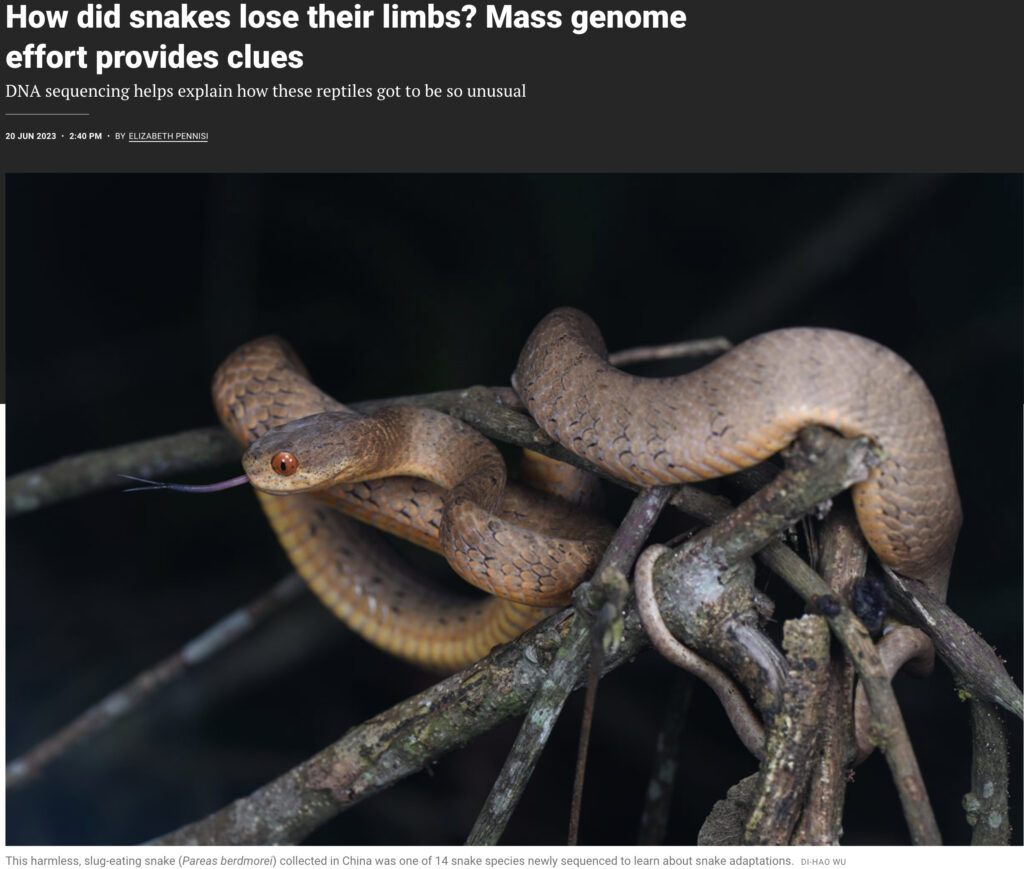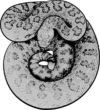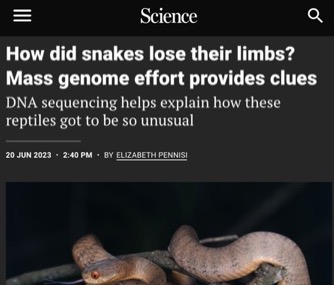
A few brief quote from Todd in today’s issue of Science Magazine, in a news commentary about a recent paper in Cell with 14 new diverse snake genomes , as part of a Science (doi: 10.1126/science.adj3359) news piece on the article and its findings: “How did snakes lose their limbs? Mass genome effort provides clues: DNA sequencing helps explain how these reptiles got to be so unusual” by Elizabeth Pennisi:
Their bodies are typically too thin for more than one lung, they smell with their tongues, and—perhaps most importantly—they have no legs. Now, an extensive effort to sequence the genomes of more than a dozen snake species has uncovered mutations that likely helped make these appendages vanish, as well as the DNA underlying other unusual traits.
This research “will undoubtedly have a transformative impact on snake and vertebrate biology,” says Todd Castoe, an evolutionary biologist at the University of Texas at Arlington who was not involved with the work.
To conduct the study, Jia-Tang Li, a herpetologist at the Chengdu Institute of Biology at the Chinese Academy of Sciences, and colleagues sequenced the genomes of 14 species of snake in 12 families, a sample that spans 150 million years of snake evolution. They also looked at the genomes of 11 snake species that had previously been sequenced. With the new genomes and their analyses, Li has produced “an impressive paper with mind-blowing new resources,” Castoe says.
Li is most excited about finding DNA missing from three parts of a gene called PTCH1, which helps control limb development. Other researchers had implicated mutations in DNA regions that help regulate the activity of genes like PTCH1 as at least partly responsible for legs disappearing. But now a gene itself is implicated. Because all snakes have these same PTCH1 mutations, Li says, it “could be one of the important genetic bases underlying snakes’ limb loss.”
When Li’s team made those same mutations in the mouse equivalent of that gene, the mice had much shorter toe bones. That’s further evidence that this gene plays a role in the snake’s leglessness, the team reports this week in Cell.
The research also sheds light on other genetic peculiarities of snakes. Based on analyses of earlier, less complete snake genomes, scientists thought the reptiles had lost genes key for vision. But the new work indicates the genes are still there; it’s just that their activity was muted and perhaps even silenced early on in snake evolution—most likely in primitive snakes that lived underground.
This “downregulation” also seems true of genes associated with the ability to hear high frequencies, but that genetic change may have led to the reptiles’ reconfigured ear bones, which make them exquisitely sensitive to vibrations. And to make all the organs fit, snakes are also missing two genes, DNAH11 and FOXJ1, which typically guide an embryo’s development to make sure its body is symmetrical—with two lungs, for example. Without these genes, the snake’s left lung is much reduced if it forms at all, Li and colleagues report.
The work is a step toward not only identifying key genes in snake development, but also pinpointing how development shapes other vertebrates, including humans, and thus identifying what might go awry and cause disease or malformations, Li says.
One might think that such extreme genetic rewiring would be too much for any animal to handle, Castoe says. But when it comes to snakes, he says, “no developmental or physiological program is off limits.”
(https://www.science.org/content/article/how-did-snakes-lose-their-limbs-mass-genome-effort-provides-clues)
.

